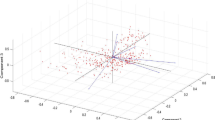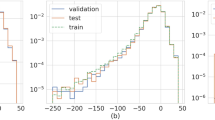Abstract
Space weather prediction involves advance forecasting of the magnitude and onset time of major geomagnetic storms on Earth. In this paper, we discuss the development of an artificial neural network-based model to study the precursor leading to intense and moderate geomagnetic storms, following halo coronal mass ejection (CME) and related interplanetary (IP) events. IP inputs were considered within a 5-day time window after the commencement of storm. The artificial neural network (ANN) model training, testing and validation datasets were constructed based on 110 halo CMEs (both full and partial halo and their properties) observed during the ascending phase of the 24th solar cycle between 2009 and 2014. The geomagnetic storm occurrence rate from halo CMEs is estimated at a probability of 79%, by this model.





Similar content being viewed by others
References
Bishop C M 1995 Neural Networks for Pattern Recognition; Oxford University Press Inc. New York, USA.
Bruckner G E, Howard R A, Koomen M J, Korendyke C M, Michels D J, Moses J D, Socker D G, Dere K P, Lamy P L, Lleberia A, Bout M V, Schwenn R, Simnett G M, Bedford D K and Eyles C J 1995 The Large Angle Spectroscopic Coronagraph (LASCO); Sol. Phys. 162 357–402.
Conway A J 1998 Time series, neural networks and the future of the Sun; New Astron. Rev. 42 343–394.
Dryer M, Smith Z, Fry C D, Sun W, Deehr C S and Akasofu S I 2004 Real-time shock arrival predictions during the Halloween 2003 epoch; Space Weather 2 S09001, doi: 10.1029/2004SW000087.
Echer E, Gonzalez W D, Tsurutani B T and Gonzalez A L C 2008 Interplanetary conditions causing intense geomagnetic storms (Dst ≤ −100 nT) during solar cycle 23, 1996–2006; J. Geophys. Res. 113 A05221, doi: 10.1029/2007JA012744.
Gonzalez W D and Tsurutani B T 1987 Criteria of interplanetary parameters causing intense magnetic storms (Dst of less than –100 nT); Planet. Space Sci. 35 1101–1109, doi: 10.1016/0032-0633(87)90015-8.
Gopalswamy N, Yashiro S and Akiyama S 2007 Geoeffectiveness of halo coronal mass ejections; J. Geophys. Res. 112 A06112, doi: 10.1029/2006JA012149.
Hung M S, Hu M Y, Shanker M S and Patuwo B E 1996 Estimating posterior probabilities in classification problems with neural networks; Int. J. Comput. Intelligence and Organizations, pp. 149–60.
Jolliffe I 2002 Principal Component Analysis; Springer Publication.
Lundstedt H and Wintoft P 1994 Prediction of geomagnetic storms from solar wind data with the use of a neural network; Ann. Geophys. 12 19–24, doi: 10.1007/s00585-994-0019-2 10.1007/s00585-994-0019-2.
Lundstedt H 1997 AI techniques in geomagnetic storm forecasting; In: Magnetic Storms (eds) Tsurutani B T, Gonzalez W D, Kamide Y and Arballo J K, Geophys. Monogr. Ser. AGU, Washington D.C., 98 243–252.
Lundstedt H, Gleisner H and Wintoft P 2002 Operational forecasts of the geomagnetic Dst index; Geophys. Res. Lett. 29 2181, doi: 10.1029/2002GL016151.
Lundstedt H, Liszka L and Lundin R 2005 Solar activity explored with new wavelet methods; Ann. Geophys. 23 1505–1511, doi: 10.5194/angeo-23-1505-2005.
Macpherson K P, Conway A J and Brown J C 1995 Prediction of solar and geomagnetic activity data using neural networks; J. Geophys. Res. 100 735–744.
Pallocchia G, Amata E, Consolini G, Marcucci M F and Bertello I 2006 Geomagnetic Dst index forecast based on IMF data only; Ann. Geophys. 24 989—999, doi: 10.5194/angeo-24-989-2006.
Richard M D and Lippmann R P 1991 Neural network classifiers estimate Bayesian a Posteriori probabilities; Neural Computation 3 461–483.
Robbrecht E, Berghmans D and Van der L. 2009 RAM Automated Lasco CME catalog for solar cycle 23: Are CMEs scale invariant?; Astrophys. J. 691 (2) 1222.
Siscoe G and Schwenn R 2006 CME disturbance forecasting; Space Sci. Rev. 123 453–470.
Srivastava N 2005 A logistic regression model for predicting the occurrence of intense geomagnetic storms; Ann. Geophys. 23 2969–2974, doi: 10.5194/angeo-23-2969-2005.
Srivastava N and Venkatakrishnan P 2004 Solar and interplanetary sources of geomagnetic storms during 1996–2002; J. Geophys. Res. 109 A10103, doi: 10.1029/2003JA010175.
Uwamahoro J, McKinnell L A and Cilliers P J 2009 Forecasting solar cycle 24 using neural networks; J. Atmos. Sol.-Terr. Phys. 71 569–574.
Uwamahoro J, McKinnell L A and Habarulema J B 2012 Estimating the geo-effectiveness of halo CMEs from associated solar and IP parameters using neural networks; Ann. Geophys. 30 963–972.
Valach F, Revallo M, Bochnicek J and Hejda P 2009 Solar energetic particle flux enhancement as a predictor of geomagnetic activity in a neural network-based model; Space Weather 7 S04004, doi: 10.1029/2008SW000421.
Wang Y M, Ye P Z, Wang S, Zhou G P and Wang J X 2002 A statistical study on the geoeffectiveness of the Earth-directed coronal mass ejections from March 1997 to December 2000; J. Geophys. Res. 107 A11, doi: 10.1029/2002JA009244.
Webb D F 2000 Coronal mass ejections: Origins, evolution, and role in space weather; IEEE Trans. Plasma Sci. 28 1795–1806.
Webb D F, Cliver E W, Crooker N U, St Cyr O C and Thompson B J 2000 Relationship of halo coronal mass ejections, magnetic clouds and magnetic storms; J. Geophys. Res. 105 7491–7508.
Woolley J W, Agarwarl P K and Baker J 2010 Modeling and prediction of chaotic systems with artificial neural networks; Int. J. Numerical Methods in Fluids 63 2117, doi: 10.1002/fld.2117.
Acknowledgements
This work is financially supported by ISRO, Bangalore under ISRO-SSPS to BHU. We acknowledge the authors of the LASCO/SOHO catalogue list of CMEs, available online at http://cdaw.gsfc.nasa.gov/CMElist http://cdaw.gsfc.nasa.gov/CMElist which was used for our study. We would also like to thank the National Aeronautics and Space Administration for providing us the necessary data of the most significant flare, available online at http://hesperia.gsfc.nasa.gov/goes/goes_event_listings/goes_xray_event_list_2014.txt. We are also thankful to the reviewers for their suggestions to improve the quality of the manuscript.
Author information
Authors and Affiliations
Corresponding author
Additional information
Corresponding editor: K Krishnamoorthy
Rights and permissions
About this article
Cite this article
SINGH, G., SINGH, A.K. A study on precursors leading to geomagnetic storms using artificial neural network. J Earth Syst Sci 125, 899–908 (2016). https://doi.org/10.1007/s12040-016-0702-1
Received:
Revised:
Accepted:
Published:
Issue Date:
DOI: https://doi.org/10.1007/s12040-016-0702-1




